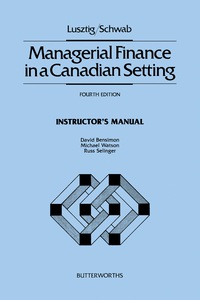Question
Exhibit 1: The expected cash flows in US$ from the project in Ohio and North Dakota. Year Cash flow (Ohio) Cash flow (ND) 0 (2,200,000)
Exhibit 1: The expected cash flows in US$ from the project in Ohio and North Dakota.
| Year | Cash flow (Ohio) | Cash flow (ND) |
| 0 | (2,200,000) | (2,450,000) |
| 1 | 450,000 | 350,000 |
| 2 | 558,000 | 185,000 |
| 3 | 562,000 | 205,000 |
| 4 | 587,000 | 300,000 |
| 5 | 600,000 | 370,000 |
| 6 | 625,000 | 590,000 |
| 7 | 630,000 | 500,000 |
| 8 | 685,000 | 483,000 |
| 9 | 690,000 | 480,000 |
| 10 | 692,000 | 620,000 |
The companys policy is to select projects using NPV technique and IRR. The cost of capital is 12% for the Ohio project and 10% for ND project.
1. You have been hired as a financial consultant to help evaluate the project. Baldwin Inc. wants you to do the following:
a. Calculate the payback period (PBP) for the two projects.
b. Calculate the profitability Index (PI) for the two projects.
c. Calculate the Internal Rate of Return (IRR) for the two projects.
d. Calculate the Net Present Value (NPV) for the two projects.
e. Use the NPV technique to recommend which investment project it should accept, assuming the cost of capital of financing the Ohio project is 12% and 10% for the North Dakota project?
2. Lok knows how bad forecast can ruin capital budgeting decisions. If the cost of capital changes from 12% to 13% for Ohio project and remains the same for ND project, does the company have to pursue the project?
3. Lok wants to analyze the risk of the project using sensitivity analysis and Monte Carlo simulation.
a. Explain to Baldwin Inc. how the two risk analysis models can be used to analyze risk of the project.
4. Lok has estimated the fixed costs (including depreciation) of the Ohio project to be $6 million, sales price is $2,000, and the variable cost is $800, giving a contribution margin of $1,200. What is the accounting profit break-even quantity for this project?
5. Baldwin Inc. wants to know the likely effect of the capital budgeting decision on its stock price (increase, decrease, no change, or not sure). Choose one and explain why.
Step by Step Solution
There are 3 Steps involved in it
Step: 1

Get Instant Access to Expert-Tailored Solutions
See step-by-step solutions with expert insights and AI powered tools for academic success
Step: 2

Step: 3

Ace Your Homework with AI
Get the answers you need in no time with our AI-driven, step-by-step assistance
Get Started


